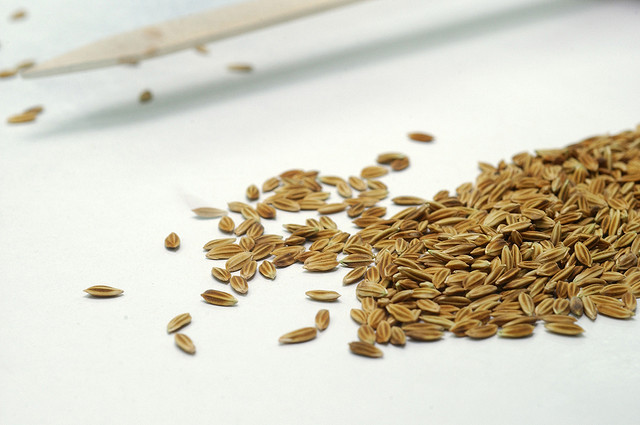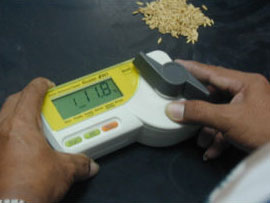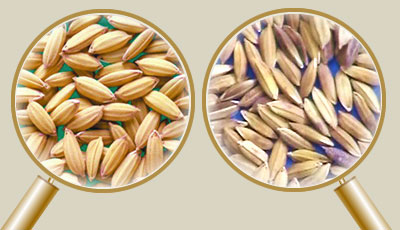Varietal purity
Good seed is pure, from a single variety.
Varietal purity tests include looking for percentage of (1) germination, (2) other mixed in varieties, (3) weed seeds and other crop seeds, (4) inert material (stones, soil, etc.), (5) red rice seeds, and (6) moisture content.
 Seed lot purity
Seed lot purity
Impurities refer to the degree of contamination caused by (1) weed seeds, (2) seeds of other crops or species, and (3) inert material such as stones, dirt, or twigs. It is expressed as a percentage, by weight.
To measure seed lot purity:
- Randomly select a seed sample. 100 g is a good sample size.
- Weigh the sample. [A]
- Remove all of the weed and other crop seeds.
- Weigh the removed weed and other crop seed matter. [B]
- Compute the weed percentage using the following formula:

- Weigh the inert matter removed from the sample [C], the inert matter percentage is calculated using the formula:

 Germination percentage
Germination percentage
Germination percentage expresses the proportion of the total number of seeds that are alive. Good seeds have more than 80% germination rate.
Many varieties have a dormancy period immediately after harvest. When stored under traditional open systems, the germination rate of most rice seed begins to deteriorate rapidly after 6 months.
To test seed germination:
- Select a number of small random samples from the seed to be planted and select a subset (e.g., 200 seeds) of the combined sample. Soak the seed in water for 24 hours.
- Arrange 100 soaked seeds in a grid pattern on a wet paper towel.
- Place the paper in a closed container or
- Cover the seeds with another moist paper towel and roll together and place the sample in a plastic bag
- Ensure paper remains moist (but not wet to the point of water running off – or seed will rot).
- Count the germinated seeds 3 and 5 days later and record how many have germinated.
- Compute the germination percentage using the following formula:

At least 80 seeds should have germinated to be considered "good seed" (80% germination).
Fact sheet:
Seed establishment vs germination
It is best to also check seed germination in soil, as emergence can often be 70% or less of germination.
To test, place 2 samples of 100 seeds in a tray filled with soil. Cover lightly with soil (e.g., 5 mm), keep moist and count establishment after 7 days.
Note: Larger seeds tend to establish better then smaller seeds.
 Discoloration
Discoloration
Fungi, bacteria, and environmental conditions such as high humidity and temperature (i.e. 27−35°) cause discoloration.
Other rice diseases do not produce consistent discoloration. Any seed having more than 0.5% differently colored or spotted seed surface is considered discolored. Discoloration can occur on fully or partially filled or empty grains.
There are two types of discoloration on rice seeds:
- Spotting, which is caused by certain diseases (brown spot) or insects (rice bug feeding damage)
- Discoloration on a portion or portions of rice seeds can be caused by black kernel fungus, stackburn disease, or sheath rot on certain occasions.
Red Rice kernels are not acceptable in the rice market place. Kernels should not have more than 25% of its surface area colored red or red streaked.
Seed size, plumpness, and/or fullness are generally desirable seed characteristics. These indicate that the seed can potentially produce vigorous seedlings under favorable conditions.
Fact Sheet:
Read:
Seed viability
 The viability of seed in the field is determined by its germination potential, vigor, and moisture level.
The viability of seed in the field is determined by its germination potential, vigor, and moisture level.
The rate of germination is an indicator of vigor.
Rapid seed germination increases the chance that seed will establish well in the field.
Fact sheet:
Seed vigor refers to the seed’s level of activity and performance during germination and seedling emergence. The ability of the germinating seed to continue to grow and survive is important in crop establishment.
Seeds that are low in vigor generally produce weak seedlings that are susceptible to environmental stresses. On the other hand, seeds that are high in vigor produce early and uniform stand, which gives them a competitive advantage against environmental stresses.
Moisture content
 Moisture content is the amount of water in the rice grain.
Moisture content is the amount of water in the rice grain.
It influences the life and vigor of the seed. The amount of moisture should be less than 14%, and preferably less than 12% for extended storage times.
 Good quality seeds (left) are uniform in size, full, and plump; while poor quality seeds (right) are often discolored.Seed is the foundation of any rice crop. It must be grown, harvested, and processed correctly for best yield and quality results.
Good quality seeds (left) are uniform in size, full, and plump; while poor quality seeds (right) are often discolored.Seed is the foundation of any rice crop. It must be grown, harvested, and processed correctly for best yield and quality results.






 The viability of seed in the field is determined by its germination potential, vigor, and moisture level.
The viability of seed in the field is determined by its germination potential, vigor, and moisture level. Moisture content is the amount of water in the rice grain.
Moisture content is the amount of water in the rice grain.










